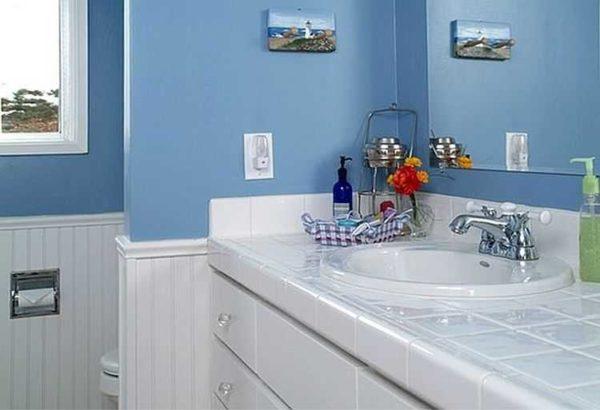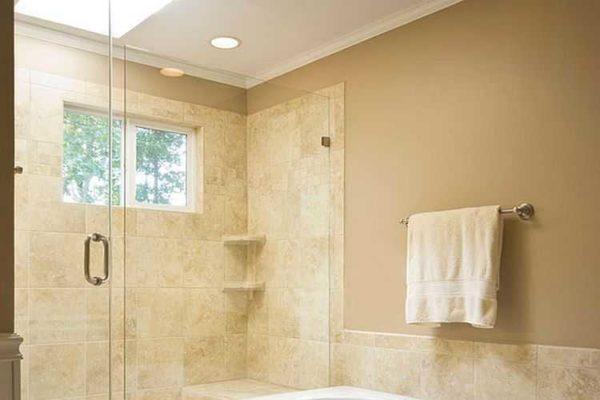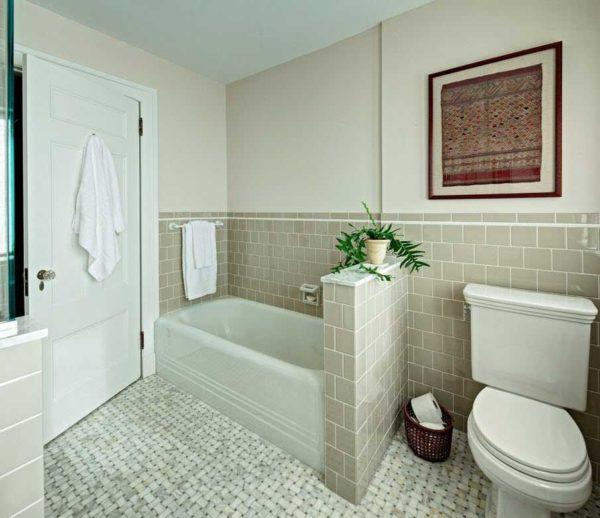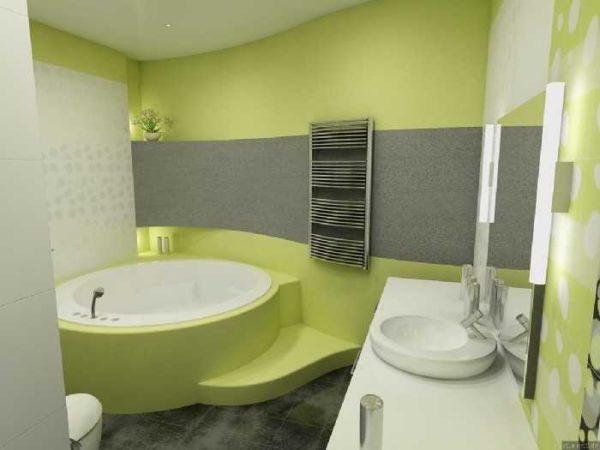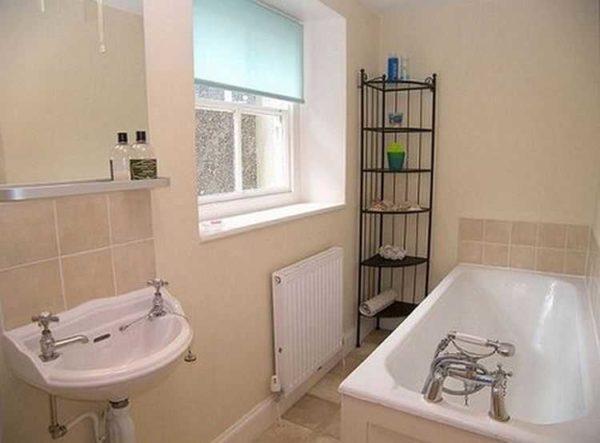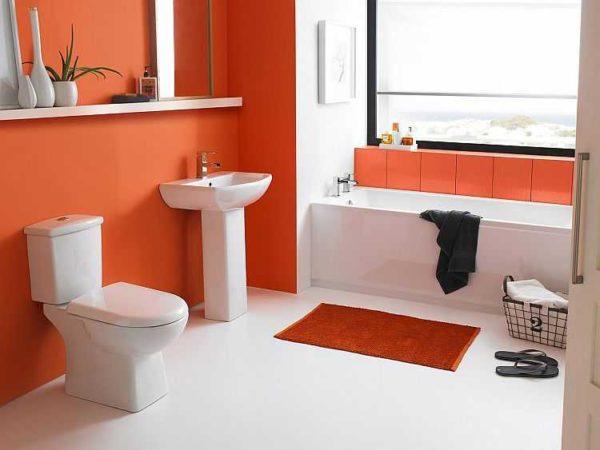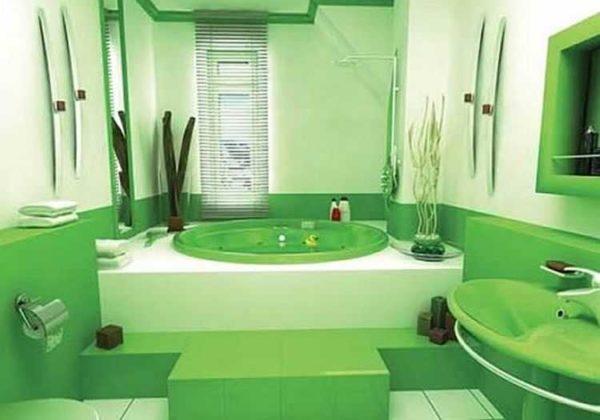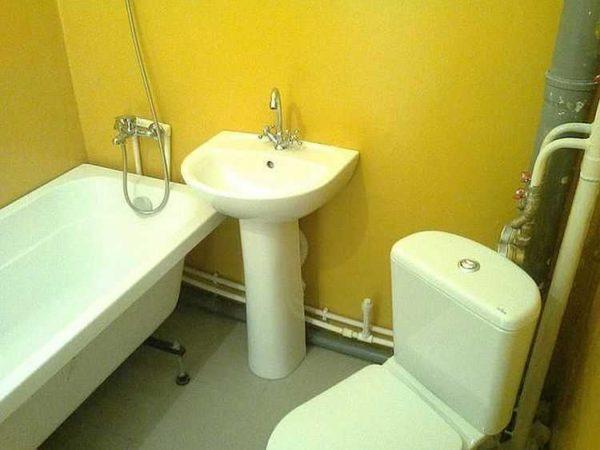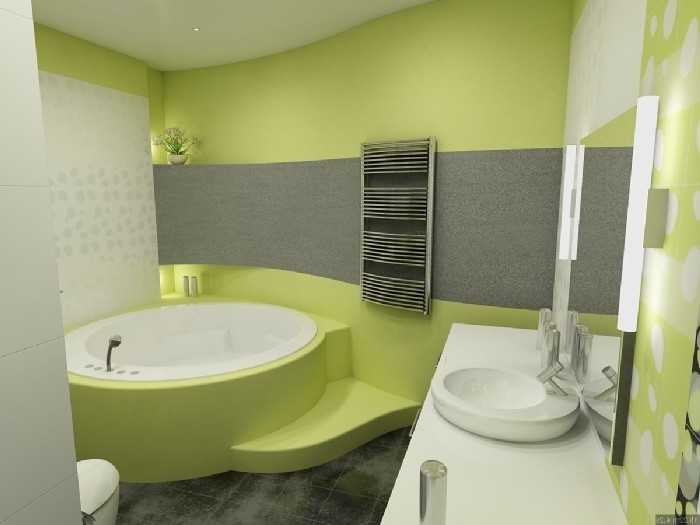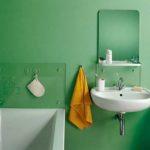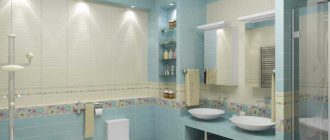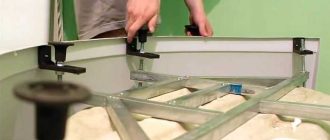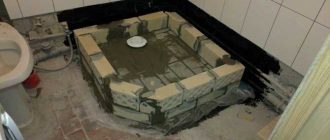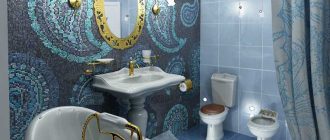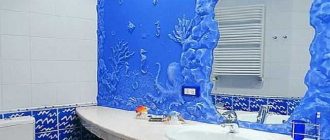Tiled walls in the bathroom are a commonplace. Yes, it is convenient and practical, but the atmosphere is far from home and in winter in such a room is frankly cold and uncomfortable. More and more people are looking for an alternative way of finishing. And one of them is painting the walls. But the paint for the bathroom must have certain characteristics. About what paints can be used in the bathroom and we will talk further.
Contents of the article
How you can paint the bathroom
Paint the walls in the bathroom can be painted in different ways. Some choose a combined version of finishing – a shower cabin or part of the wall near the bathtub is finished with tile, the rest – painted. In this case, the choice of paints is greater, as many easily tolerate high humidity, but not all can withstand the effects of hot chlorinated water.
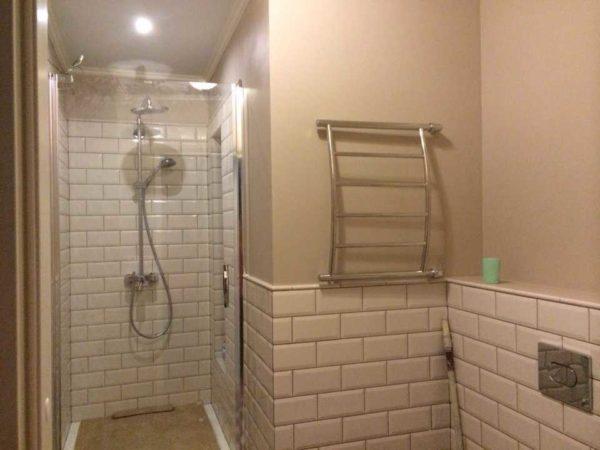
If you do not like tiles even in limited quantities, you can cheat – finish the painted walls in the splash zone with glass or transparent sheet polycarbonate.
- Painted walls in the bathroom can be protected with glass or polycarbonate panels
- It is not necessary to cover all the walls completely
- Design approach)))
Many still have concerns about whether it is possible to hang a towel rail on the painted wall. The answer is – you can, there are no restrictions and there will be no consequences either. Next about what paints can be painted bathroom walls.
What paint can be used in the bathroom
For wet rooms can be used not all paints and in the case of the bathroom still requires high cleaning power. These types are suitable:
Chlorinated rubber paint is often still recommended. Yes, it creates a waterproof coating, as it was developed for swimming pools. But it can only be used at temperatures not exceeding +27°C. It makes sense to use it in the area of water splashes, because after drying the formed film is more like rubber than paint and does not let either water or air pass through. But there is a high probability that the water will get warmer than necessary. How this paint will behave or what it will start to emit is not voiced, but it is hardly worth the risk, as the cost is high, and the results of application are questionable.
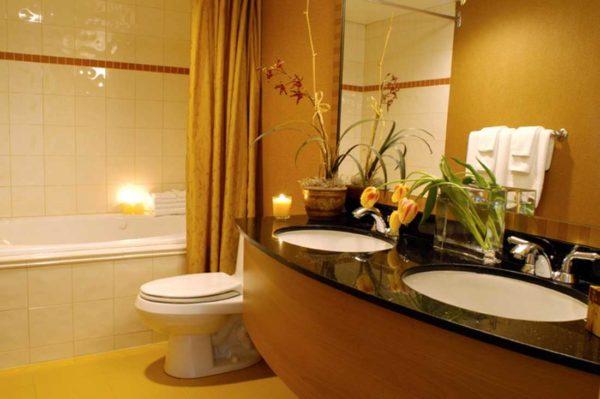
As you can see, there is a choice, but there is no ideal option. Everywhere there are disadvantages. And in general, the paint for the bathroom has any serious manufacturer and often not one. If there is no direct indication that it is designed for the bathroom and kitchen, it is written “washable” and “water resistant” or “waterproof”. When choosing, pay attention to the number of brush passes (it should also be written). This figure is measured in thousands and the more it is, the better. Minimum for walls – 3000 passes, but most of the good compositions this figure overlaps many times. For example, Livna “PS-285” withstands 20000 passes with a soft brush. That is, in characteristics it is close to Tikkurila, and costs many times cheaper.
Latex paint: characteristics
Latex can be natural and synthetic. Latex paints are made on the basis of natural latex – the juice of rubber trees. These particles are dissolved in water and do not form rigid bonds. As the water dries, a resilient waterproof film is formed on the surface. Its merits are as follows:
- Easy to apply.
- Dries quickly.
- Virtually odorless.
- The coating is resistant to abrasion.
- Durable.
- Easy to clean.
- Can be tinted with various pigments.
Paint is applied with a roller or brush. For normal coloring it is desirable to apply 2 layers. To reduce the paint consumption it is desirable to prim the surface beforehand.

There are disadvantages, too:
- To make the paint look good, perfect preparation of the walls is necessary – a thin film will emphasize all the shortcomings.
- Not suitable for unheated rooms. The lower temperature threshold is +10°C.
- Before painting, the walls must be treated with antifungal compounds.
- High price.
Basically latex paint for the bathroom is not bought because of the high price. If you look at the price per liter, so it is. But it should be taken into account that the consumption of this paint is very small, so that it will be necessary to buy a small amount. The second point to consider is that the painted surface does not change its appearance for a long time. With it literally nothing happens for years. So “expensive” is relative.
Another point: if you want to have a “silky” shine on the walls of the bathroom, you need exactly latex paint. No other paint gives this effect.
Acrylate (acrylic or polyacrylic)
Acrylate is one type of latex paint. As a base, one of the types of synthetic rubber – acrylate – is used, because of which the composition received its name. The properties of acrylic paint for the bathroom can be called optimal:
- Weak and non-resistant odor when drying and its complete absence after.
- Moisture resistance. When water gets on the dried surface nothing happens. Dried acrylic does not dissolve, does not enter into any reactions.
- Vapor permeability. The dried composition does not interfere with gas exchange.
- Good adhesion (adherence to the surface to be painted).
- Can be used at high and low temperatures. If you are looking for water-resistant paint for the bath – it is a good choice.
- Does not burn out under the influence of ultraviolet light.
- High resistance to abrasion. Antivandal coatings are made of acrylic paints.
- Safety. Does not contain salts of heavy metals and organic solvents.
- No distinct odor.
If you need a bright and deep color – your choice of acrylic paint for the bathroom. And this color is retained for a very long period of time. An additional bonus – the versatility of the composition: it can be applied to concrete, metal, glass, stone, plastic, brick, plaster.
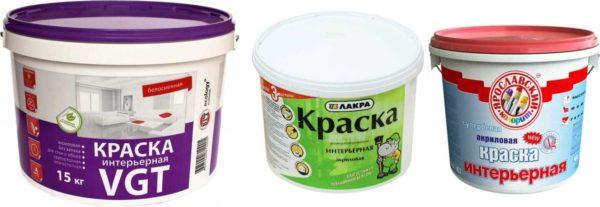
The disadvantages of acrylic paint are also worth knowing:
- Long drying time.
- Low dry residue (about 30%), which means that the film turns out thin and requires good surface preparation.
- Only acrylic paint lies on top of acrylic paint. If you want to change, you will have to remove it completely.
Overall, acrylic bathroom paint is a good choice. Painted bathroom walls will retain their color for a long time.
Silicone water dispersion
Silicone paint, as well as latex and acrylic paint, are waterborne dispersions. This means that it is also odorless and well applied. However, it has its own peculiarities. Here are its advantages:
- Good adhesion. It can be applied on concrete, putty, brick, wood, stone, etc.
- Does not require a perfect surface, hides roughness, small cracks.
- Can be used at high and low temperatures.
- The film repels water but allows vapor and gas to pass through. That is, the walls or ceiling covered with silicone paint “breathe”.
- Prevents the development of fungi and microorganisms.
- Easy to clean.
- Well tolerates the effects of sunlight.
- Long service life (up to 25 years).
If you need such a paint for the bathroom that the walls and ceiling “breathe” – choose silicone paint. It is good in problematic rooms where there is mold or fungus.
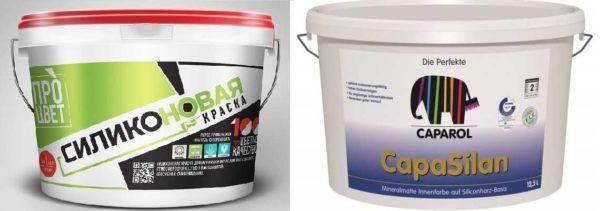
Disadvantages are also available:
- Price. Not the cheapest paint. But looking at the service life, you realize that the costs are justified.
- This paint is undesirable to use on metal: it is vapor permeable, which leads to the fact that the metal quickly rusts. When painting reinforced concrete, measures are required to protect the reinforcement – impregnation with anticorrosion compounds.
Silicone paint is applied like any water-based paint, using a roller or brush. To reduce the consumption of expensive composition, it is desirable to pre-prime the surface. The primer should also be on the silicone base. Work begins at plus temperature (usually above +5°C) and normal humidity. The composition should be applied to clean dry walls or ceiling.
Alkyd enamel
This type of paint can be used not only for the bathroom, but also for exterior or interior works. The main disadvantage is a strong odor when applying and drying, since the solvent is white spirit. Alkyd enamels of domestic production are often toxic, so it is necessary to work in a ventilated room and better – in a respirator – gas mask. Also, the composition may include filler (very finely ground stone chips or sand), pigment to give color, may be antibacterial or antiseptic additives.
Advantages of alkyd enamels:
- High film strength.
- Resistance to aggressive environments.
- Short drying time.
- Low price.
- Not bad adhesion.
- Does not yellow and does not crack.
- Wide temperature range of application.
When choosing, it is better to opt for imported products. The price differs significantly, but so does the quality. Most importantly, imported alkyd enamel smells much less and is definitely non-toxic.
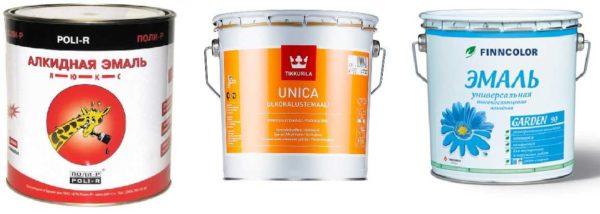
The disadvantages have basically already voiced: odor and toxicity, but there is also another unpleasant moment:
- The surface covered with alkyd paint does not allow air and steam to pass, so that the ventilation system in the bathroom must be effective.
- To prevent fungus from appearing in the bathroom, it is necessary to protect the base beforehand.
Alkyd enamel has two forms of release: standard – in cans, as well as in aerosols. Aerosols are more universal – can be applied to any surface, they are also easier to paint hard-to-reach places, but are more expensive.
Oil paint
Oil paints are made on the basis of olifa or synthetic oils. Compositions on olifa are considered the best, but they are more expensive. In the base is added ground into flour minerals, which are responsible for the color of the coating. These particles are insoluble, and since they are heavier than oils, they settle to the bottom. Therefore, before application and during work the paint must be stirred. The advantages of this type of paint:
- Low price.
- Waterproof coating.
- Lays down well on a properly prepared surface.
- Good adhesion.
- Can be used for painting metal and wood.
If you need inexpensive paint for the bathroom – this is your option. It is only worth considering that the service life of such coatings is very short: in places of direct contact with water quickly formed bubbles, the paint begins to crack and peel.
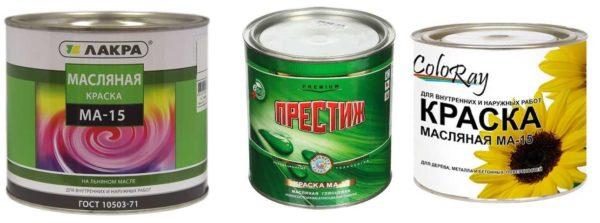
Disadvantages of oil paint:
- The composition includes organic solvents, so the odor before drying is strong and persistent.
- The fumes can be toxic.
- Fewer colors due to the use of only mineral pigments.
- Long drying time – at least 6 hours. Throughout this time, the paint “smells”.
- After a while the paint changes color (yellow tint is added). It burns out quickly in the sun.
- In wet areas it cracks and peels.
The combination of these qualities leads to the fact that oil paints are used less and less often. Even a low price does not save, so you have to update the coating almost annually. At the same time, the normal appearance is preserved for a few months. In general – this is the most unsuccessful paint for the bathroom of all described.
What kind of paint can be recommended
Even after choosing the type of paint that you want to use in your bathroom, it is not easy to choose a specific brand: there are so many different proposals. Therefore, it is easier to navigate if there are recommendations of those who already have some experience of using painted walls in the bathroom. Here are the paints that have good reviews:
- Caparol Capamix Samtex 20 (latex paint).
- Livna PS 285. Washable paint for highly stressed walls (use not in water ingress area).
- Dulux Ultra Resist (acrylic).
- Benjamin Moor Kitchen & Bath Satin Finish (acrylic); Aura Interior Matte Finish (silicone).
- Raduga Extra (acrylic).
- Tikkurila (Tikkurila). There are several variants Luja 40 (acrylate for wet areas), Luja 7 (acrylate washable for heavy duty areas), Euro Extra 20 (semi-matte),
- VGT Kitchen and Bathroom IQ130 (acrylic).
There are many other paints, but these have been used in bathrooms before, so they are tried and tested. These are mostly acrylic paints, the others are apparently used less often as they cost more. All of them give a matte or semi-matte surface – this is the latest trend in decoration. The plus side of this choice is that surface defects (if any) are not as conspicuous as on those painted with glossy and semi-glossy paints.
A few last photos of how you can paint a bathroom – for inspiration.
